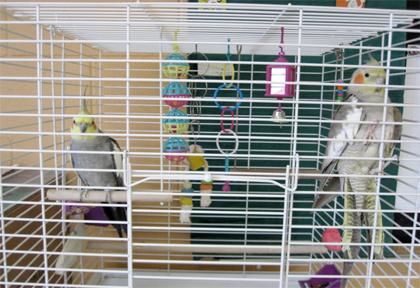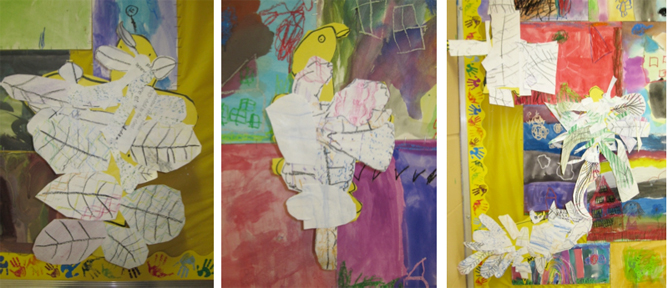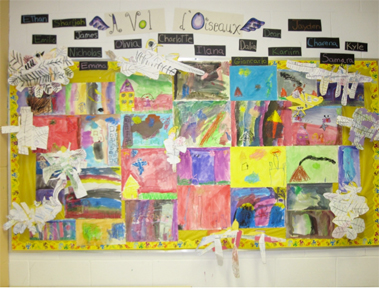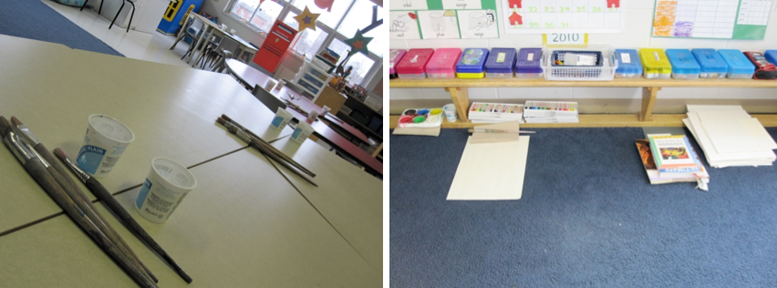

Catherine-Emmanuelle Drapeau
4th year, Art Education Specialization
Learning with Children and Birds: Pre-School Teaching Practicum Final Report
At 7:51 am, I felt overwhelmed by the miniature stature and immaturity of the children. As they sipped their morning milk, one child began to sob, feeling left out of a ‘Dora The Explorer’ game. Another child was twisting her body on the carpet like a worm as another youngster crawled up my leg, roaring like a lion. I thought to myself: “This is a jungle, and I’m going to be babysitting monkeys and lions.”
Between January and April 2010, I taught art to kindergarten children as a student-teacher. The experience was one of growth, discovery and, most importantly, love for a population that until then had been unfamiliar to me. The present paper offers an analysis of the successes and challenges encountered during my teaching experiences and summarizes my general appreciation for this experience. Visual documentation supports my reflection.
Meeting the Students and my Co-operating Teacher
My teaching practicum began on January 23rd, 2010. At 7:50 a.m., I met the seventeen kindergarten students as well as my co-operating teacher (CT). At 7:51am, I felt overwhelmed by the miniature stature and immaturity of the children. As they sipped their morning milk, one child began to sob, feeling left out of a ‘Dora The Explorer’ game. Another child was twisting her body on the carpet like a worm as another youngster crawled up my leg, roaring like a lion. I thought to myself: “This is a jungle, and I’m going to be babysitting monkeys and lions.” Alleviating my sense of panic, my CT introduced herself (in French) as being very laid-back and flexible. “You know, what I love about kindergarten is that there is no stress. They are magical and lovely, and we’re simply here to give them the opportunity to play, create and grow,” she said, as the miniature cub was still clutched to my leg. Throughout my internship, her words were proven through action as I observed her adapt the daily plans and activities to accommodate the children’s needs.
She proceeded to introduce me to the children: a group of four and five year olds, made up of half boys and half girls. As my internship would progress, I would find the group to be well balanced, pleasant, cooperative and exempt from any major behavioral problems. I however noticed early in my internship a potential case of Attention Deficit Hyperactivity Disorder (ADHD), and two cases of possible dyslexia. In regards to art making, one boy had trouble with cutting (something we worked on together throughout the practicum to improve successfully). No other issues arose for the art lesson or for the general classroom. As a matter of fact, I had the opportunity to discover their avid interest in art on this very first day as the children worked on an in-process winter mural.
Throughout my experience, I witnessed my CT model assertive discipline strategies mixed with a very flexible and playful attitude towards teaching. Clear and simple rules were regularly reminded and used. Her positive approach to teaching was also reflected in her response to my art teaching. She was always enthused with art activities I proposed and gave me the freedom to use the themes, materials and time frame that I felt better suited the art lesson. She supported my approach to art teaching with preschool children, which consists of providing clear guidelines and inspiration at the beginning of the lesson, followed by letting the children use their creativity to take the art to wherever their imagination may lead.
The children adopted me instantly and initiated the introduction tour of the classroom. In the midst of initial meetings and presentations of the classroom’s organization, toys, treasures, art materials, I was also acquainted with Cookie and Toupet, the two classroom birds. Meeting the two animal friends not only dissipated the subtle anxiety I was feeling towards the new population (preschool children), but they instantly filled me with inspiration for art activities. I decided that I would relate all my art lessons to birds. That is exactly what I did, to complete success.
Teaching Art: The Outcomes of the First Activity – Cookie and Toupet: Observational drawings of birds
On the second day of my internship, we had been instructed to guide the students in a drawing activity exploring their family and themselves. Without undermining the value of such an activity, I felt compelled to challenge the children with an observational drawing activity. I hoped this lesson would encourage the children to truly ‘see’ the birds and their environment, and consequently develop more respect for them.
The greater goal of this first activity was to set the stage for a number of interrelated activities that would not only develop artistic skill and knowledge but collaborative skills as well as environmental awareness. I agree with author Suzi Gablik who writes, “We have been taught to experience the self as private, subjective, separate, from others and the world” (1995, p.78). My objective with this first lesson and subsequent ones was to break this cycle of individualistic learning and guide the children towards a collaborative approach to art in which they can nourish their sense of self in a communal setting and develop a true connection with all environments.
During the activity, I animated a discussion focused on the general geometrical shapes that could be observed when looking at Cookie and Toupet and their home (the bird cage). The children were directed to consider all the elements before them. Quoting American Abstract painter Vicci Sperry in The Art Experience (1969, p.77), “… the space is as important to the painting as the objects…. Every area no matter how small, no matter how large, is equally important to the whole.” I encouraged the children to feed off of each other’s observations to appreciate all the shapes before them. Afterwards, still gathered around the birds, they each executed observational drawings of their friends in their home. They were praised for helping each other with observations and technical aspects of the activity and for simply interacting with each other and the bird friends. In the end, they had exchanged ideas, some had helped each other with the execution of their drawing, and all had a successful observational drawing attesting their deeper appreciation of their bird friends.
Other Activities – Rubbings, Feathers and a Mural
In the weeks following the observational drawing activity, the children’s connection to their bird friends was solidified through the study of their coating (feathers) and of their anatomy. Appreciating the texture of feathers and textures in the environment, the children created rubbings. They then studied the structure of feathers and created their own feathers with line drawings. Afterwards, they worked in teams of two or three to put their feathers and efforts together to create birds. This activity required me to act as a mediator in no more than one slight quarrel between two children. One child wanted feathers on the head, the other did not. Remaining calm, I asked the children if they knew what it means to compromise. Once I explained what compromising means, one child suggested “If we don’t put feathers on the head, then can we make an extra long tail?” They continued to work in peace!

Finally, the children were invited to step out of their skin and into that of a bird, fly high above the trees and into the clouds to consider a bird’s eye view of the environment. I was fully aware this last activity risked being too challenging for the children. However, having seen them work incredibly well together, help each other, and consider each other’s needs and wants, I had complete confidence in their capacity for empathy. Not all children understood the technical aspect of the activity (drawing objects viewed from above), but all children grasped the concept of representing what they would see if they were Cookie or Toupet flying in the sky.

In conclusion to this series of activities, all artworks were brought together to create a colourful and collaborative mural. The children worked together in guiding the visual organization of mural and democratically chose a title for the work: À Vol d’Oiseaux (In Bird’s Flight). While debriefing as a form of art response on the collaborative mural experience, I discovered the children felt empowered by seeing the results of their teamwork. They were able to recount the different learning elements they had retained throughout the activities (shape, line drawing, textures, a bird’s anatomy, benefits of teamwork, etc). I however would only truly appreciate the project as successful later, when in the context of the following project, children would, on their own, choose to work together towards a collaborative goal.

When I announced we would go outside and use what we found in the environment to build nests and gave them the choice to either build smaller individual nests or one large scale nest collaboratively, the entire class, with a moment of hesitation, yelled, “One big one! All together!”
On the last day of my internship, I invited the children to think about where Cookie and Toupet would live if they were not in the classroom. The question-based discussion lead the children to talk about the outdoor environment, about the trees that offer a foundation for birds’ homes, about nests, what they are made of and how they are made, and about what would happen if we did not recycle and if we litter without considering the environment. I was bewildered by their sensitivity towards the environment and by their ability to reflect on the consequences of people’s environmental calamities. They were then introduced to the environmental art of Nil’s Udo, more specifically to The Nest (1978), an outdoor sculpture formed from earth, stones, birch trees, birch branches and grass (Green Museum, 2010).
When I announced we would go outside and use what we found in the environment to build nests and gave them the choice to either build smaller individual nests or one large-scale nest collaboratively, the entire class, without a moment of hesitation, yelled “One big one! All together!” Before going outside, we decided on conduct rules (no hitting or poking with twigs or branches, consider each other’s opinions, share, help each other, etc), and we discussed the meaning of the word ‘ephemeral’. Throughout the activity, the children were reminded of the impermanence of environmental art. I would ask: “What happens if someone trips over the artwork in the night? Or if a big wind breaks it apart?” The children answered: “It’s ok! Like the birds, we can always work together to build another one! Plus we will have pictures of today’s activity!”
Outdoors, the children worked incredibly well together to collect materials and create the structure that would become a giant nest. There were no disciplinary issues or interventions to be made. In addition to interacting and connecting with the natural environment, the children learned to appreciate it as a living entity. Holding a broken branch revealed the green sap of a tree, I asked the children if they knew how to tell if a branch is dead and alright to use for the nest or if it was alive and should be left to grow. One child looked at the broken branch and yelled in amazement “Look! That’s its blood!” The children learned to respect and protect the fragile life that is beginning to blossom. This kind of interaction with the environment is essential if we want to take the first steps towards putting children on an early path to environmental sustainability (Young, 2009, p.39). In the end, the entire class worked hard and collaboratively to create a large-scale nest that they were all very proud of.
Reflection on Philosophical and Technical Approach
Considering the challenges I faced during my internship, I am reminded of the extent to which the cooperating teacher can influence the outcome of the experience. I was initially intimidated by this young population that was unfamiliar to me. However, my insecurities were quickly dissipated with the help of my calm and joyful cooperative teacher. She modeled a positive and flexible approach to teaching that inspired me to feel comfortable in the preschool setting.
There are two facets of my internship to consider for its success: the technical approach and the philosophical approach. Firstly addressing the technical aspect of my internship, I found organization, consistency in structure and discipline strategies to be the key contributors to the smooth development of each activity. Every lesson began with a tippy-toe entrance into the classroom, trying to trick our bird friends in being invisible to them! This excited the children and engaged them into a playful and positive attitude towards the activity. Materials would be pre-organized and the motivation would always take place on the communal carpet. Previous learning was reviewed before introducing new knowledge. Each lesson was concluded with collaborative clean up. The routine was held consistently throughout my entire internship and I believe this gave the children the chance to feel safe and comfortable during art making activities.

Secondly, I believe applying my teaching philosophy to my practice had an important role to play in the success of the internship. According to Soviet psychologist Lev Vygotsky, social interactions are greatly influential in the development of superior mental functions (as cited in Portelance & Ouellet, 2004, p.73). In my opinion, social interactions at a young age not only stimulate the development of higher thinking skills but also nourish important life skills such as collaboration, empathy, citizenship, etc. I believe children as young as four and five years old have a great amount of knowledge and skill to share with each other and are already capable of being independent and collaborative learners. As a matter of fact, according to Portelance and Ouellet, pre-school children are capable of developing metacognitive skills with the active and consistent support of adults (p.94).
Putting into practice my appreciation for Vygotsky’s ideas and my belief in the children’s capability to overcome obstacles set before them, I challenged the children with technically and conceptually advanced activities (observational drawing, imagining aerial perspective, collaborative and ephemeral art) through a question-based learning approach that fostered active and spoken reflection. In support for Portelance and Ouellet’s approaches to developing metacognitive functions in young children (2004, p.77), I also modeled metacognitive behaviours by describing my thought processes aloud during each demonstration. As I encouraged them to interact and to reflect aloud, children began to turn not only to me but to each other and work together to find answers to questions or solutions to technical problems. In nurturing their ability to create and work collaboratively by bringing their individual strengths together, I saw the children grow more confident and daring in their art. I saw them take initiatives not only in art activities but also in other classroom activities. I believe a sense of trust was built between the children and me, which enabled authentic art learning and experience. This is the most cherished lesson I have gained from my internship: believe in the children and they will grow in their belief in themselves and each other!
Considering the challenges I faced during my internship, I am reminded of the extent to which the cooperating teacher can influence the outcome of the experience. I was initially intimidated by this young population that was unfamiliar to me. However, my insecurities were quickly dissipated with the help of my calm and joyful cooperative teacher. She modeled a positive and flexible approach to teaching that inspired me to feel comfortable in the preschool setting.
The main challenge I faced was classroom discipline. During my first teaching experiences I found the children’s energy and noise levels skyrocketed as soon as they were engaged in the art making period of the activity. The ‘invisible game’ was the solution to the issue. I first had them notice how the birds’ chirping changed along with their noise levels. They became aware of how calm the birds were when they were calm. From then on, the children began every lesson by trying to be invisible to Cookie and Toupet. This allowed each activity to develop in a more relaxed atmosphere and helped in keeping energy and noise levels under control.
In conclusion, my internship in the preschool setting was an enriching experience that confirmed my love for teaching, for art and for children. Throughout the practicum, I worked to surpass my initial insecurity toward teaching kindergarten children and discovered a setting and population with which I can truly put to practice my pedagogical philosophy. I was able to be creative in lesson planning, to base my lesson plans on the children’s interests, experiences and immediate environments, to nourish the development of their artistic and social skills and environmental awareness, all in a stress-free atmosphere. In retrospect, I was incredibly fortunate to have a cooperative teacher who supported my approach to art teaching and who modeled a flexible and optimistic approach that inspired my own teaching attitude and methods. The children surpassed all my expectations and proved themselves to be creatively and technically skilled, respectful and supportive of each other, as well as being respectful to others and the environment. They are engaged, passionate and, quite honestly, magical, offering me an experience that makes me look forward to future opportunities for working in preschool settings.
References
Gablik, S. (1995). Connective aesthetics. In S. Lacy (Ed.), Mapping the terrain: New genre public art (p.74-87). Seattle: Bay Press.
Green Museum. (2010). Nils Udo. Available from greenmuseum.org.
Portelance, L. & Ouellet, G. (2004). Vers l’énoncé d’interventions susceptibles de favoriser l’émergence de la métacognition chez l’enfant du préscolaire. Revue de l’Université de Moncton, 35(2), p. 67-99.
Sperry,V.(1969). The art experience. Boston: Boston Book and Art Shop Inc.
Young, L. (2009, Fall). Shallow grade: Environmental education is gaining momentum in Canada, but are we doing too little too late? Greenliving, p. 38-42.